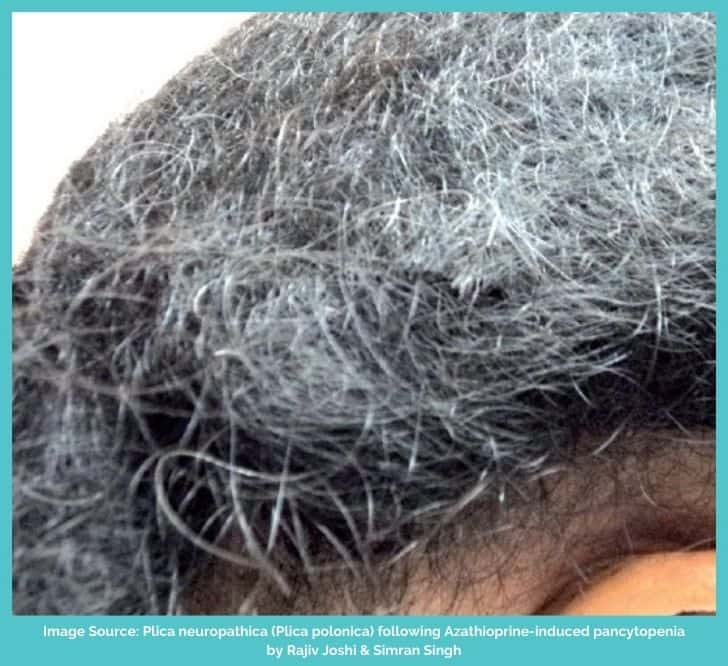Plica polonica is a hair shaft disorder characterised by the irregular twisting and matting of the hair. As a result, a hard mass can form that is moist or sticky with an odour.
How this actually happens isn’t well understood, but different risk factors for this condition have been identified.
It is possible to treat this condition, but it usually involves cutting or trimming the hair down. Since that can be quite distressing, many people want to avoid that.
There are, however, some things that can help you in preventing this disorder. In this guide, you’ll find out what plica polonica is and what you can do about it.
What Is Plica Polonica?
Plica refers to a condition of the hair in which it’s significantly matted. Polonica, however, refers to the prevalence of this disease in Poland as far back as the 16th century. It was because of the Polish custom of not washing one’s hair and wearing tight fur caps.

J.F. Le Page first coined the term “plica polonica” in 1884 in his case report titled “On Neuropathic Plica.” But there are other names for this hair disorder, such as:
- Bird’s nest hair
- Plica neuropathica
- Dreadlocks
- Polish plait
Le Page described the condition as causing scalp inflammation and tenderness, with hair follicles secreting a fluid.
According to him, the fluid clumped the hair and turned it into a solid mass after drying. He attributed this to a “nerve-force” in the hair.
For a long time, it was believed that plica polonica was associated with diseases of the other organs and systems, such as the skin, hair, blood vessels, heart, nervous system, etc.
However, today, it’s attributed to certain “physical and chemical factors,” according to a study published in the International Journal of Trichology.
This hair matting can be diffuse or localised (limited to one area of the scalp). And it can happen quite suddenly. Additionally, it should be noted that it’s usually accompanied by infestations (lice and nits).
According to a study published in the American Journal of Tropical Medicine and Hygiene, this condition is most common in female children between the ages of 3 and 12.
Interestingly, plica has also been an “expression of superstition and religious beliefs” for many centuries, according to a research published in Modern Medicine.

What Are The Symptoms Of Plica Polonica?
Signs and symptoms of plica polonica can include the following:
- Hard mass of matted hair that cannot be combed out
- Crusts of blood, pus, and dirt in the entangled hair
- Scalp inflammation
- Coarse, rough hair
- Swollen lymph nodes

According to DermNet, entangled hair loss can cover as much as 70% of the scalp and can occur with diffuse alopecia on the rest of the scalp.
What Causes Plica Polonica?
Plica polonica can be caused by any of the following:
- Infection
- Psychiatric illness (e.g. schizoghrenia)
- Lice infestation (pediculosis capitis)
- Poor hygiene and haircare
- Psoriasis
- Seborrheic dermatitis
- Cationic surfactants (founds in shampoos and conditioners)
- Sweating
- Medication (e.g. docetaxel, azathioprine)
- Poor health
According to a study published in the Archives of Dermatology, the process of matting is like “felting” in textile-making. In this, the animal fibres are compacted following exposure to friction and compression in a liquid medium.
And according to different researches, aggressive rubbing of the hair, hair weathering, longitudinal splitting, and repeated manipulation of long hair are all believed to cause this.
Some suggest that the disulfide bonds in the hair are damaged. While according to others, the sticky cortex of the hair is exposed, which ends up entangling some of the hair.
What Is The Treatment For Plica Polonica?
Treatment for plica polonica can depend on the severity of the problem. If it’s in its early stages, it can be possible to separate the hair manually using an organic solvent. However, it’s rarely possible. Usually, the hair needs to be cut or trimmed short.
Depending on the condition of your scalp, you might also need a prescription for insecticides like permethrin lotion. For an infection, you might also need an antibiotic.
How To Prevent Plica Polonica?
You may be able to prevent plica polonica by doing the following:
- Washing the hair and keeping the scalp clean.
- Making sure to condition the hair after shampooing.
- Locking moisture in your hair with oils.
- Getting regular hair trims.

You should also try to be more gentle with your hair when, for instance, you’re drying it with a towel.
Additionally, if you have a scalp or hair problem, you should make sure to consult a doctor first. In the Indian Dermatology Online Journal, there’s a case report of a patient who developed plica polonica only after using a canthalin-based shampoo for dandruff.
Therefore, you need to be careful about what you’re putting on your scalp and hair.
Conclusion
Plica polonica is an irregular matting of the hair, which results in the formation of a firm mass (of hair). And this mass can inhabit more than half of the scalp.
It’s so tightly wound that it’s not possible to comb it out. Additionally, it can be accompanied by infection and infestations.
Therefore, it’s very important to seek the help of a medical professional. Rarely it can be untangled manually, but usually, it requires cutting the hair. Moreover, you might need medications to treat the scalp skin.
FAQ
Is plica polonia reversible?
In its early stages, it can be possible to reverse the hair matting caused by plica polonica. However, if it’s caused significant tangling, cutting the hair might be the only option.
How do you treat plica polonica?
Plica polonica is usually treated with cutting of the hair. Although, in rare cases, manual untangling might also be possible.



